
The Racial Achievement Gap in the United States
Encyclopedia
The Racial Achievement Gap in the United States refers to the educational disparities between minority students and Caucasian students. This disparity manifests itself in a variety of ways: African-American and Hispanic students are more likely to receive lower grades, score lower on standardized tests, drop out of high school, and are less likely to enter and complete college. Asian-Americans generally perform similarly to Caucasian students and are therefore usually not studied in conjunction with Hispanics and African-Americans. There are several different factors that cause this gap, which are detailed below.
, differences in parenting styles can impact a child’s future achievement. In her book Unequal Childhoods
, she argues that there are two main types of parenting: concerted cultivation and the achievement of natural growth.
Concerted cultivation
is usually practiced by middle-class parents, regardless of their race. These parents are more likely to be involved in their children's’ education, encourage their children's participation in extracurricular activities or sports teams, and to teach their children how to successfully communicate with authority figures. These communication skills give white children a form of social capital that help them communicate their needs and negotiate with adults throughout their life.
The achievement of natural growth is generally practiced by poor and working-class families, many of whom are Hispanic or African-American. These parents generally do not play as large a role in their children’s education, their children are less likely to participate in extracurriculars or sports teams, and they usually do not teach their children the communication skills that middle- and upper-class children have.
A child's exposure to technology can also influence their academic performance. In the year 2000, by the time they had reached kindergarten, almost all upper-class children, about half of middle-class children, and fewer than one in five lower-children had used computers. This disparity in technology use is often reflected in the computer literacy practices of the children's parents.
Using property taxes to fund public schools contributes to school inequality. Lower-funded schools are more likely to have (1) lower-paid teachers; (2) higher student-teacher ratios, which means less individual attention for each student; (3) older books; (4) fewer extracurricular activities, which have been shown to increase academic achievement; (5) poorly maintained school buildings and grounds; and (6) less access to services like school nursing and social work. All of these factors can impact student performance and perpetuate inequalities between students of different races.
However, the achievement gap is not solely caused by this common difference in school quality between Caucasian and minority students. Differences in the academic performance of African-American and Caucasian students exist even in schools that are desegregated and diverse, and studies have shown that a school’s racial mix does not seem to have much effect on changes in reading scores after sixth grade, or on math scores at any age
African-American students are also likely to receive different messages about the importance of education, but from their peer group and from their parents. Many young African-Americans are told by their parents to concentrate on school and do well academically, which is similar to the message that many middle-class white students receive. However, the peers of African-American students are more likely to place less emphasis on education. This causes problems for black students who want to pursue higher levels of education, forcing some to hide their study or homework habits from their peers and perform below their academic potential.
Research has shown time and again that that the wealth and income of parents is one of the primary factors influencing student achievement. A low socioeconomic background can have negative effects on a child’s educational achievement before he or she even starts school; indeed, research has shown that the achievement gap is present between races before starting formal education. A major reason for this is that children in poor families are typically exposed to fewer education-related activities when they are young. This is evidenced by the fact that many minority students begin school with vocabularies that contain much fewer words than the vocabularies of their Caucasian peers. Parents who have less income are less likely to spend money on books for their children, and it is hard for young children to develop their vocabulary skills when there are very few books at home.
Economic differences between white and minority families can also perpetuate the racial achievement gap throughout a child’s schooling. Caucasian families are more likely to be able to afford private tutors, SAT or ACT prep classes, and college counselors than Hispanic or African-Americans. These services give Caucasian students another advantage over their minority counterparts and can contribute to differences in grades, test scores, and college attendance rates.
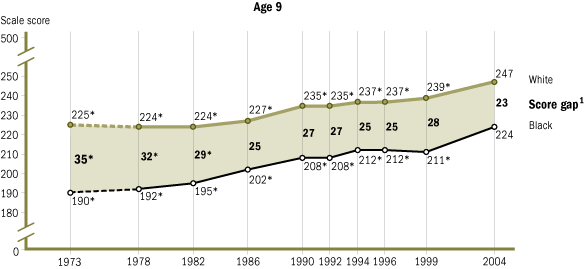

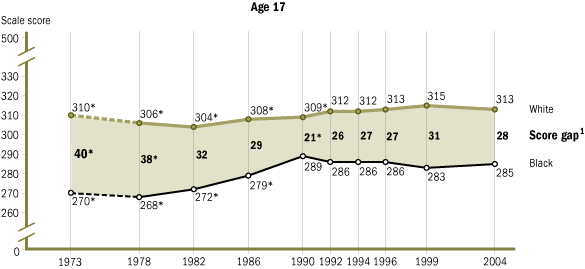
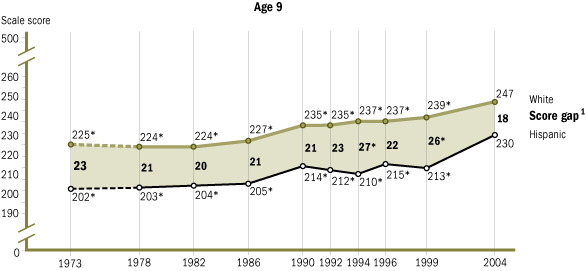

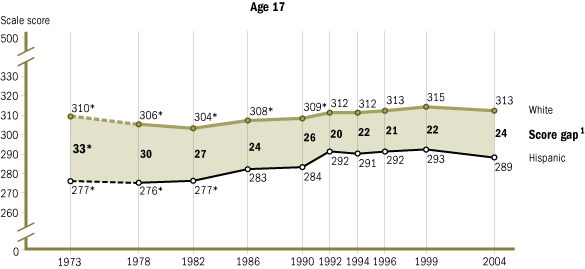
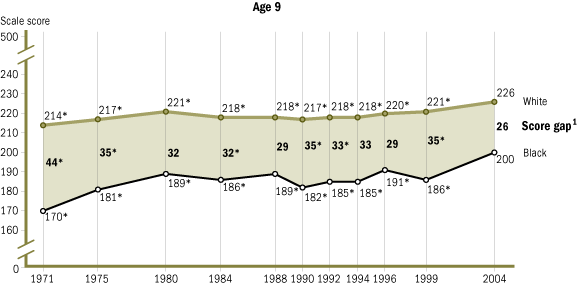
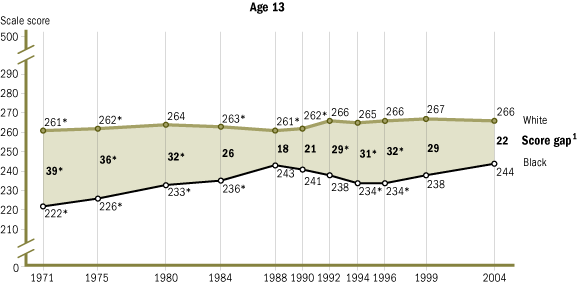
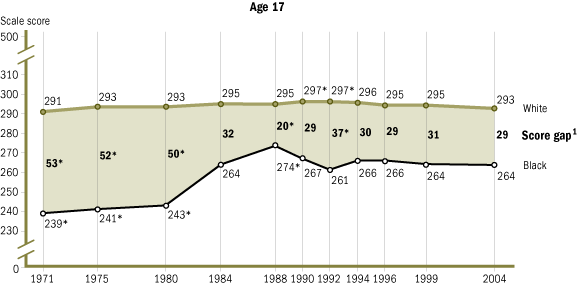


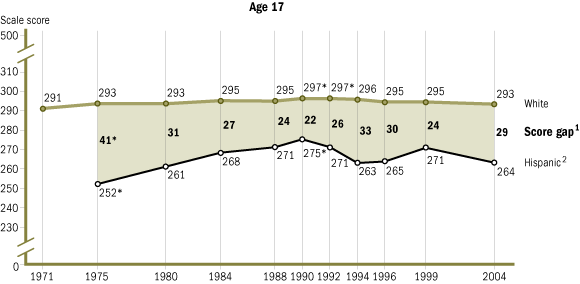
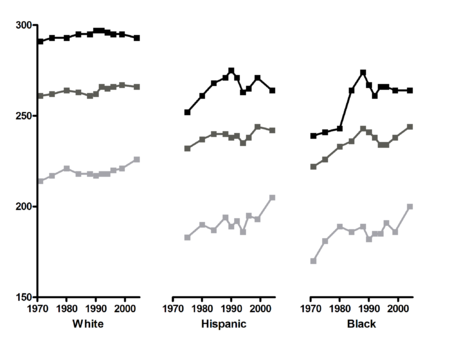
Students with lower achievement are more likely to drop out of high school, which means that when they enter the workforce, they are more likely to work for minimum wage and earn less. Today’s society is also increasingly focused on technology, which means that many employers are having difficulty filling jobs that require good academic skills. Well-educated citizens are vital to the strength of America’s democracy and economy. Therefore, eliminating the racial achievement gap and improving the achievement of minority students will help eliminate economic disparities and ensure that America’s future workforce is well prepared to be productive and active citizens.
This is especially important because the United States is becoming an increasingly diverse country. The percentage of African-American and Hispanic students in school is increasing: in 1970, African-Americans and Hispanics made up 15% of the school-age population, and that number had increased to 30% by 2000. It is expected that minority students will represent the majority of school enrollments by 2015. Minorities make up a growing share of America’s future workforce; therefore, the United States’ economic competitiveness depends heavily on closing the racial achievement gap.
One example of standards-based reform was Goals 2000
, also known as the Educate America Act. Goals 2000 was enacted in 1994 and aimed to provide resources to states and communities to make sure that all students achieved their full potential. This program set forth eight goals for American students, including increasing the high school graduation rate to at least 90% and increasing the standing of American students to first in the world in achievement in math and science. Goals 2000 also placed an emphasis on the importance of technology, promising that all teachers would have modern computers in their classroom and that effective software would be an integral part of the curriculum in every school. The Goals 2000 program was essentially replaced by No Child Left Behind, and at that time the United States had not met any of the goals explicitly outlined by the program. However, other results were mixed: students demonstrated a higher math proficiency in elementary and middle school, but teacher quality and school safety decreased.
was put into effect in the United States. This law focuses heavily on standards-based reform: in order to receive federal funding for education, individual states must develop standardized tests to measure student achievement and progress. NCLB also gives families more power over school choice. If their child’s school continually fails to meet Adequate Yearly Progress
, parents can choose to send their child to a school that is not failing.
NCLB has shown mixed success in eliminating the racial achievement gap. Although test scores are improving, they are improving equally for all races, which means that minority students are still behind whites. There has also been some criticism as to whether an increase in test scores actually corresponds to improvements in education, since test standards vary from state to state and from year to year.
, more commonly known as KIPP. KIPP has several unusual policies: students attend school during the summer and on Saturdays, which results in KIPP students being in a classroom 60% more than non-KIPP students. The underlying principle of KIPP schools is that “there are no shortcuts.” Students are held to high expectations by their teachers and follow a rigorous curriculum designed to prepare them for college. The minority students who attend KIPP schools have shown much higher test scores, grades, and rates of college enrollment than their non-KIPP minority peers. However, some critics have argued that these results are somewhat skewed because KIPP schools tend to serve the minority students with the highest rates of parental involvement and personal motivation.
Achievement Gap in the United States
Knowledge is Power Program
Origin of the Racial Achievement Gap
The achievement gap between low-income minority students and middle-income Caucasian students has been a popular research topic among sociologists since the publication of the report, "Equality of Educational Opportunity" (more widely known as the Coleman Report). This report was commissioned by the U.S. Department of Education in 1966 to investigate whether the performance of African-American students was caused by their attending schools of a lesser quality than white students. The report suggested that both in-school factors and home/community factors impact the academic achievement of students and contribute to the achievement gap that exists between races.Family Factors
Children can differ in their readiness to learn before they enter school. According to sociologist Annette LareauAnnette Lareau
Annette Lareau is a sociologist working at the University of Pennsylvania. She is a graduate of U.C. Santa Cruz and earned her PhD in Sociology from U.C. Berkeley. She started her career at South Illinois University at Carbondale and also previously worked as a Professor of Sociology at Temple...
, differences in parenting styles can impact a child’s future achievement. In her book Unequal Childhoods
Unequal childhoods
Unequal Childhoods: Class, Race, and Family Life is a 2003 non-fiction book by American author Annette Lareau based upon a study of 88 families to understand the impact of how social class makes a difference in family life, more specifically in children's lives...
, she argues that there are two main types of parenting: concerted cultivation and the achievement of natural growth.
Concerted cultivation
Concerted cultivation
Concerted cultivation is a style of parenting that is marked by a parent's attempts to foster their child's talents through organized leisure activities. This parenting style is commonly exhibited in middle and upper class American families...
is usually practiced by middle-class parents, regardless of their race. These parents are more likely to be involved in their children's’ education, encourage their children's participation in extracurricular activities or sports teams, and to teach their children how to successfully communicate with authority figures. These communication skills give white children a form of social capital that help them communicate their needs and negotiate with adults throughout their life.
The achievement of natural growth is generally practiced by poor and working-class families, many of whom are Hispanic or African-American. These parents generally do not play as large a role in their children’s education, their children are less likely to participate in extracurriculars or sports teams, and they usually do not teach their children the communication skills that middle- and upper-class children have.
A child's exposure to technology can also influence their academic performance. In the year 2000, by the time they had reached kindergarten, almost all upper-class children, about half of middle-class children, and fewer than one in five lower-children had used computers. This disparity in technology use is often reflected in the computer literacy practices of the children's parents.
Geographic and Neighborhood Factors
The quality of school that a student attends can affect a student's academic performance. In the United States, the financing of most public schools is based on local property taxes This system means that schools located in areas with lower real estate values (typically, predominantly Africa-American or Hispanic neighborhoods) have proportionately less money to spend per pupil than schools located in areas with higher real estate values (typically, predominantly Caucasian neighborhoods). This system has also maintained a “funding segregation:” because minority students are much more likely to live in a neighborhood with lower property values, they are much more likely to attend a school that receives significantly lower funding.Using property taxes to fund public schools contributes to school inequality. Lower-funded schools are more likely to have (1) lower-paid teachers; (2) higher student-teacher ratios, which means less individual attention for each student; (3) older books; (4) fewer extracurricular activities, which have been shown to increase academic achievement; (5) poorly maintained school buildings and grounds; and (6) less access to services like school nursing and social work. All of these factors can impact student performance and perpetuate inequalities between students of different races.
However, the achievement gap is not solely caused by this common difference in school quality between Caucasian and minority students. Differences in the academic performance of African-American and Caucasian students exist even in schools that are desegregated and diverse, and studies have shown that a school’s racial mix does not seem to have much effect on changes in reading scores after sixth grade, or on math scores at any age
Cultural Factors
Some experts believe that cultural factors contribute to the racial achievement gap. Both Hispanic and African-American youths often receive mixed messages about the importance of education, and often end up performing below their academic potential. Many Hispanic parents who immigrate to America see a high school diploma as being a sufficient amount of schooling and may not stress the importance of continuing on to college. However, counselors and teachers usually promote continuing on to college. This message conflicts with the one being sent to Hispanic students by their families and can negatively affect the motivation of Hispanic students, as evidenced by the fact that Latinos have the lowest college attendance rates of any racial group.African-American students are also likely to receive different messages about the importance of education, but from their peer group and from their parents. Many young African-Americans are told by their parents to concentrate on school and do well academically, which is similar to the message that many middle-class white students receive. However, the peers of African-American students are more likely to place less emphasis on education. This causes problems for black students who want to pursue higher levels of education, forcing some to hide their study or homework habits from their peers and perform below their academic potential.
Economic Factors
Some research has suggested that the disparity in income that exists between minorities and Caucasians directly contributes to the racial achievement gap. The origin of this “wealth gap” is the slavery and racism that made it extremely difficult for African-Americans to accumulate wealth for almost 100 years; a comparable history of discrimination created a similar gap between Hispanics and whites. This results in many minority children being born into low socioeconomic backgrounds, which in turn affects a educational opportunities .Research has shown time and again that that the wealth and income of parents is one of the primary factors influencing student achievement. A low socioeconomic background can have negative effects on a child’s educational achievement before he or she even starts school; indeed, research has shown that the achievement gap is present between races before starting formal education. A major reason for this is that children in poor families are typically exposed to fewer education-related activities when they are young. This is evidenced by the fact that many minority students begin school with vocabularies that contain much fewer words than the vocabularies of their Caucasian peers. Parents who have less income are less likely to spend money on books for their children, and it is hard for young children to develop their vocabulary skills when there are very few books at home.
Economic differences between white and minority families can also perpetuate the racial achievement gap throughout a child’s schooling. Caucasian families are more likely to be able to afford private tutors, SAT or ACT prep classes, and college counselors than Hispanic or African-Americans. These services give Caucasian students another advantage over their minority counterparts and can contribute to differences in grades, test scores, and college attendance rates.
Evidence of the Racial Achievement Gap: National Assessment of Educational Progress
Over the past 45 years, students in the United States have made notable gains in academic achievement. However, the racial achievement gap still exists because not all groups of students are advancing by the same intervals. Evidence of the achievement gap can be found using various measures, but one assessment used nationwide is the National Assessment of Educational Progress (NAEP). The graphs below show the achievement gap on this assessment between black and Caucasian students and between Hispanic and Caucasian students in the U.S. over time. Although the gaps have generally narrowed in recent years according to this particular measure, there are clearly still large disparities between groups.Caucasian-African American Gap



Caucasian-Hispanic gap



Caucasian-African American Gap



Caucasian-Hispanic Gap



Long-term trends

-
- Reading- ages 9 (light gray), 13 (dark gray), and 17 (black).
Implications of the Achievement Gap
The racial achievement gap has detrimental effects on minority students in form of lower reading levels and lower math skills . However, this gap also has the potential to have negative implications for American society as a whole, especially for the country’s economy.Students with lower achievement are more likely to drop out of high school, which means that when they enter the workforce, they are more likely to work for minimum wage and earn less. Today’s society is also increasingly focused on technology, which means that many employers are having difficulty filling jobs that require good academic skills. Well-educated citizens are vital to the strength of America’s democracy and economy. Therefore, eliminating the racial achievement gap and improving the achievement of minority students will help eliminate economic disparities and ensure that America’s future workforce is well prepared to be productive and active citizens.
This is especially important because the United States is becoming an increasingly diverse country. The percentage of African-American and Hispanic students in school is increasing: in 1970, African-Americans and Hispanics made up 15% of the school-age population, and that number had increased to 30% by 2000. It is expected that minority students will represent the majority of school enrollments by 2015. Minorities make up a growing share of America’s future workforce; therefore, the United States’ economic competitiveness depends heavily on closing the racial achievement gap.
Efforts to Narrow the Achievement Gap
The United States has seen a variety of different attempts to narrow the racial achievement gap. Some focus on the importance of elementary education, while others have tried to eliminate the gap using federal standards of accountability.Standards-Based Reform
Standards-based reform has been a popular strategy used to try to eliminate the achievement gap in recent years. The goal of this reform strategy is to raise the educational achievement of all students, not just minorities. States have adopted higher standards for student achievement, which makes the achievement gap between races more obvious. This type of reform focuses on scores on standardized tests, and these scores show that a disproportionate share of the students who are not meeting state achievement standards are Hispanic and African-American. Therefore, it is not enough for minorities to improve just as much as Caucasians do—they must make greater educational gains in order to close the gap.One example of standards-based reform was Goals 2000
Goals 2000
The National educational Goals were set by the U.S. Congress in the 1990s to set goals for standards-based education reform. Many of these goals were based on the principles of outcomes-based education, and not all of the goals were attained by the year 2000 as was intended...
, also known as the Educate America Act. Goals 2000 was enacted in 1994 and aimed to provide resources to states and communities to make sure that all students achieved their full potential. This program set forth eight goals for American students, including increasing the high school graduation rate to at least 90% and increasing the standing of American students to first in the world in achievement in math and science. Goals 2000 also placed an emphasis on the importance of technology, promising that all teachers would have modern computers in their classroom and that effective software would be an integral part of the curriculum in every school. The Goals 2000 program was essentially replaced by No Child Left Behind, and at that time the United States had not met any of the goals explicitly outlined by the program. However, other results were mixed: students demonstrated a higher math proficiency in elementary and middle school, but teacher quality and school safety decreased.
No Child Left Behind
In 2001, No Child Left BehindLink
Link, links, linking may refer to:- Education :* Hands On Learning Australia, implements the HOL LiNK program -Music:* Link , an American R&B singer...
was put into effect in the United States. This law focuses heavily on standards-based reform: in order to receive federal funding for education, individual states must develop standardized tests to measure student achievement and progress. NCLB also gives families more power over school choice. If their child’s school continually fails to meet Adequate Yearly Progress
Link
Link, links, linking may refer to:- Education :* Hands On Learning Australia, implements the HOL LiNK program -Music:* Link , an American R&B singer...
, parents can choose to send their child to a school that is not failing.
NCLB has shown mixed success in eliminating the racial achievement gap. Although test scores are improving, they are improving equally for all races, which means that minority students are still behind whites. There has also been some criticism as to whether an increase in test scores actually corresponds to improvements in education, since test standards vary from state to state and from year to year.
Institutional Changes
Research has shown that making certain changes within schools can have positive impacts on the performance of minority students. These include lowering class size in schools with a large population of minority students; expanding access to high-quality preschool programs to minority families; and focus on teaching the critical thinking and problem-solving skills that are necessary to retain high-level information.Success Stories of Narrowing the Racial Achievement Gap
During the 1970s and 80s, the racial achievement gap between minority and Caucasian students decreased. African-American and Hispanic students made large gains in achievement, while the achievement of white students increased only a little. Part of this progress can be attributed to federal programs such as Head Start and Title I which placed emphasis on reducing poverty and improving educational opportunity for poor and minority students.Charter Schools
In recent years, certain charter schools have made progress and managed to close the achievement gap in several urban areas. In 1994, two Teacher for America alumni started the Knowledge is Power ProgramLink
Link, links, linking may refer to:- Education :* Hands On Learning Australia, implements the HOL LiNK program -Music:* Link , an American R&B singer...
, more commonly known as KIPP. KIPP has several unusual policies: students attend school during the summer and on Saturdays, which results in KIPP students being in a classroom 60% more than non-KIPP students. The underlying principle of KIPP schools is that “there are no shortcuts.” Students are held to high expectations by their teachers and follow a rigorous curriculum designed to prepare them for college. The minority students who attend KIPP schools have shown much higher test scores, grades, and rates of college enrollment than their non-KIPP minority peers. However, some critics have argued that these results are somewhat skewed because KIPP schools tend to serve the minority students with the highest rates of parental involvement and personal motivation.
See Also
Education in the United StatesAchievement Gap in the United States
Knowledge is Power Program
External links
- http://www.edweek.org/ew/issues/achievement-gap/ Education Week: Achievement Gap

